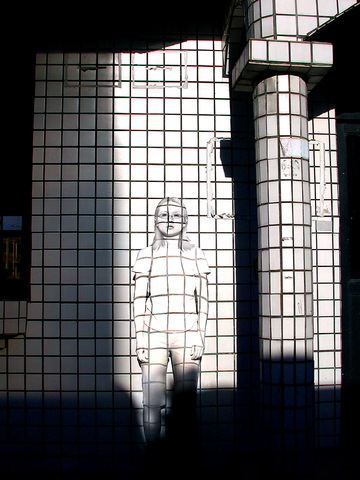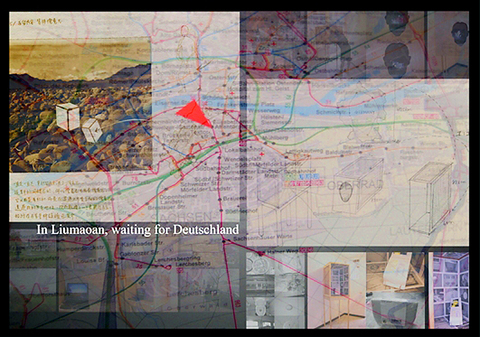There are several art exhibitions by young artists that are worth seeing in Taipei this weekend. The Taipei Artist Village may be an unfamiliar place to many readers because it is not as well known as the Taipei Fine Arts Museum, but this creative haven nestled away in a quiet little area near Taipei Main Station is a hotbed of multi-cultural activity.
It is an interdisciplinary artist residency -- something like a hotel for visual artists, dancers, writers and others from all over the world to stay in for several months in order to create new works and to interact with Taiwan. The Taipei Artist Village brings an international flavor to the already cosmopolitan art scene of Taipei. If you haven't been there yet, now is a good time to visit, as there is a group exhibition of its visiting artists that runs until August 14. Entitled Art Diary, the show features Patrick Palucki, Hung I-ching (
German mixed-media artist Patrick Palucki does experimental short film and video installations and has won many awards for his work, which deals with the phenomena of the consciousness and the psyche. He combines science, semiotics and autopoiesis, and is inspired by living in multicultural communities around the world.

Hung I-ching (
Spanish artist Alba Navas Salmer and Japanese artist Ayumi Matsuzaka work together on public art projects, but they use a conceptual artist's sensibility. They emphasize working with the people of the community and having the art truly connect with the public.
Australian Sandra Tobias shows her whimsical and colorful paintings that depict the chaotic and frenetic pace of city life. Her recent work shows life in the cramped urban space of Hong Kong. After that taste of international cosmopolitanism, you may want to experience the complex flavors of Taiwanese performance art. Opening on the 23rd is a summer series entitled Carefree -- Taiwan Performance Art Relay, which runs until Sept. 17 at the Taipei MOMA Gallery and is curated by the prominent artist, curator and writer Yao Jui-chung.

PHOTOS COURTESY OF THE TAIPEI ARTIST VILLAGE
Exhibition Notes:
What: Artist Diary
Where: Taipei Artist Village, 7, Beiping E Rd, Taipei (台北市北平東路7號)
Tel: (02) 3393 7377
When: Mon and Sun, 10am to 6pm, until August 14
What: Taipei MOMA Gallery
Where: 3F, No.19 Lane 252, Tun-Hua S Road Sec 1, Taipei (台北市大安區敦化南路一段252巷19號3樓)
Tel: (02)8771 3372
Web site: www.taipeimoma.com
When: Tue to Sat, 11am to 7pm
What: Kuo Hui-Chan's (郭慧禪) "Mimicry" and Ho Hsin's (何佳) "Writing Imagery Father Jai"
Where:Shin Leh Yuan Art Space 104, Chung-Shan N Road, Sec 2, Lane 11, No 15-2, Taipei (新樂園藝術空間,台北市中山北路二段11巷15之2號1樓)
Tel: (02)2561 1548
When: Wed to Sun, 1pm to 8pm

In the March 9 edition of the Taipei Times a piece by Ninon Godefroy ran with the headine “The quiet, gentle rhythm of Taiwan.” It started with the line “Taiwan is a small, humble place. There is no Eiffel Tower, no pyramids — no singular attraction that draws the world’s attention.” I laughed out loud at that. This was out of no disrespect for the author or the piece, which made some interesting analogies and good points about how both Din Tai Fung’s and Taiwan Semiconductor Manufacturing Co’s (TSMC, 台積電) meticulous attention to detail and quality are not quite up to

April 21 to April 27 Hsieh Er’s (謝娥) political fortunes were rising fast after she got out of jail and joined the Chinese Nationalist Party (KMT) in December 1945. Not only did she hold key positions in various committees, she was elected the only woman on the Taipei City Council and headed to Nanjing in 1946 as the sole Taiwanese female representative to the National Constituent Assembly. With the support of first lady Soong May-ling (宋美齡), she started the Taipei Women’s Association and Taiwan Provincial Women’s Association, where she

Chinese Nationalist Party (KMT) Chairman Eric Chu (朱立倫) hatched a bold plan to charge forward and seize the initiative when he held a protest in front of the Taipei City Prosecutors’ Office. Though risky, because illegal, its success would help tackle at least six problems facing both himself and the KMT. What he did not see coming was Taipei Mayor Chiang Wan-an (將萬安) tripping him up out of the gate. In spite of Chu being the most consequential and successful KMT chairman since the early 2010s — arguably saving the party from financial ruin and restoring its electoral viability —

It is one of the more remarkable facts of Taiwan history that it was never occupied or claimed by any of the numerous kingdoms of southern China — Han or otherwise — that lay just across the water from it. None of their brilliant ministers ever discovered that Taiwan was a “core interest” of the state whose annexation was “inevitable.” As Paul Kua notes in an excellent monograph laying out how the Portuguese gave Taiwan the name “Formosa,” the first Europeans to express an interest in occupying Taiwan were the Spanish. Tonio Andrade in his seminal work, How Taiwan Became Chinese,